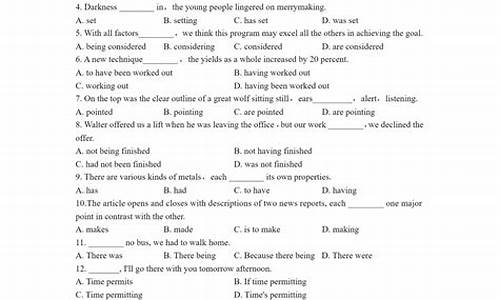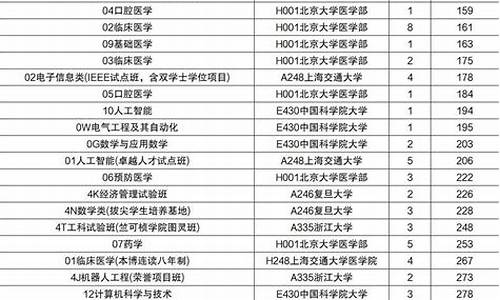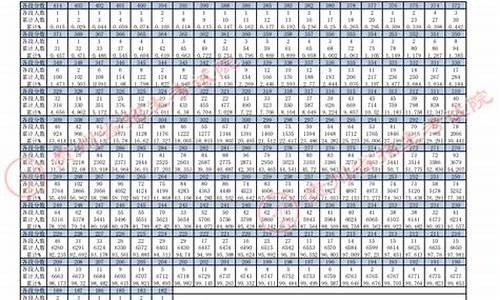您现在的位置是: 首页 > 教育改革 教育改革
高考独立主格写作运用_独立主格高考题
tamoadmin 2024-07-29 人已围观
简介1.____ we want to know is whether we must finish the work ____ you assigned last week. A.What;..2.什么时候要用独立主格呢?3.独立主格和with 的复合结构4.用独立主格写作文5.什么独立主格结构?6.高考英语语法: 英语分词的逻辑主语7.一道独立主格的题,英语高手帮忙解答一下~独立主格结构(A
1.____ we want to know is whether we must finish the work ____ you assigned last week. A.What;..
2.什么时候要用独立主格呢?
3.独立主格和with 的复合结构
4.用独立主格写作文
5.什么独立主格结构?
6.高考英语语法: 英语分词的逻辑主语
7.一道独立主格的题,英语高手帮忙解答一下~

独立主格结构(Absolute Structure)是由名词或代词加上分词等构成的一种独立结构,用于修饰整个句子。独立主格结构中的名词或代词与其后的分词等构成逻辑上的主谓关系。它的位置相当灵活,可置于主句前、主句中或主句末,常由逗号将其与主句分开。
独立主格结构的基本构成形式:名词(代词)+现在分词(过去分词、形容词、副词、不定式、介词短语等)。
例如:There being nothing else to do,?they he gone?away.?由于无事可做,他们离开了。(代词+现在分词)
独立主格结构的用法:主要用于描绘性文字中,其作用相当于一个状语从句,常用来表示时间、原因、条件、行为方式或伴随情况等。例如:
1、 表示时间
His first play a success, he wrote another.
他第一个剧本成功后,又写了另一个剧本。
2、 表示条件
The teacher to help us, we will succeed.
有老师的帮助,我们就能成功。
3、表示原因
It being Sunday, they had no classes.
由于是星期天,他们不上课。
4、表示伴随情况
He lay on his back, his face up and his hands crossed under his head.
他脸朝天,头枕着手躺着。
扩展资料
需要注意的问题:
1、 独立主格结构中分句和主句的主语不一致。含有独立主格结构的句子,前后主语是不一致的,这也是独立主格结构和非谓语分句作状语的最重要区别。
2. 在独立主格结构中,动词是用现在分词还是过去分词: 一般来说如果逻辑主语和动词之间是主谓关系,用现在分词。但如果逻辑主语和动词之间是动宾关系,并且有被动的意思,用过去分词。
3. 独立主格结构相当于一个状语从句。
4. 完成时态的运用,在独立主格结构中如果强调分词的时间发生在主句动作时间之前,常用现在分词的完成时态hing done, 根据情况确定是用主动还是被动。
____ we want to know is whether we must finish the work ____ you assigned last week. A.What;..
1.A number of art works are believed _____ during World War II.
A. being stolen B. hing been stolen
C. to be stolen D. to he been stolen
第一题:D
分析:固定句型如It is said that或者是sb./sth is said to be done,believe也是同样的道理,但是这是对过去事情的描述,主语art works 与steal是被动关系,且已经完成,故选择to he been stolen。
2.In his pioneering work, Did explains how languages come into being, _____ that children
are the driving force.
A. being argued B. hing argued
C. arguing D. agued
答案:C
首先分析主语与动词之间的关系,为主动。Did与argue是主动关系。故排除A、D。由题可知是对现在事实的表述,故用表示现在的状态。C答案正确。
3.Birdwatching is becoming a popular pastime, with almost 3,000,000 of us _____ in our
fluttering feathered friends.
A. absorbed B. absorbing
C. absorb D. to absorb
答案:A
分析:由固定短语be absorbed in sth. 去掉谓语动词be 就可得到答案。
4.The course “World Literature” examines the common people found in quality literature
worldwide and _____ a variety of cultural background.
A. introduces B. introducing
C. to introduce D. introduced
答案:A
分析:introduce是与examine并列的谓语。二者应该保持一致。
遇到这类问题的话应该首先要分析句子结构,确定动词是作谓语或者不是,如第四题作谓语。如果是非谓语动词的话,如1、2、3,就要确定 主语与谓语之间的关系。是主动还是被动。是对过去的表述还是现在或是将来。进而确定答案。
希望对你有帮助。
什么时候要用独立主格呢?
| A |
| 试题分析:句意:我们要知道的是是否我们必须完成这项你上周分配的工作。这里第一空是what引导的主语从句,它在从句中做主语;that在主语从句中不作成分,故排除CD;第二空是that引导的定语从句,先行词是work,关系词在从句中作宾语,what不能引导定语从句,故排除B。故选A。 点评:本题难度适中。定语从句和连词是高考常考的知识点,判断用哪个连词或关系词除了必须要分析句子成分外,还需理解句子的语境,只有正确理解句子的语意才能做出正确的判断。 即学即练:He has lots of friends, only a few of?______ invited to his wedding. A. whom? B. them C. which? D. who 解析:B。句意:考查定语从句和其他结构的区别。only a few of them invited to his wedding是独立主格结构,此结构不是完整句子,因此不能选其他引导词。 |
独立主格和with 的复合结构
写文章时用独立主格比用状语从句更简练优美,如果考试的话用独立主格肯定会比用状语从句更加分啊。 比如 When i was a boy,i liked playing football. 这句话如果变成独立主格的话就是 Being a boy,i liked playing football.
用独立主格写作文
不少学生对with结构的用法比较复杂,不少英语学习者总感觉不甚清楚,现将
一介词with、二with复合结构、三独立主格结构、四动词独立主格结构、五with/without 引导的独立主格结构总结如下。with结构也称为with复合结构,首先要与介词with的用法区别开来。先让我们全面了解介词with的用法。
一、介词with的用法
with prep.其主要词义包括“有, 以, 用, 同...,由于, 和...一致, 赞成, 关于......” 等21种词义。
1. the company of; accompanying:和,陪伴:在…陪伴下;随同:2.Did you go with her?你跟她一起去吗?Next to; alongside of:在…旁边,同…在一起:stood with the rabbi; sat with the family.与教士站在一起,与家人坐在一块儿3.Hing as a possession, an attribute, or a characteristic:带着,带来:作为所有物、属性或特点具有:arrived with bad news; a man with a moustache.带来坏消息;留络腮胡子的男人4.In a manner characterized by:以…方式:performed with skill; spoke with enthusiasm.很有技巧地表演;热情地说话5.In the performance, use, or operation of:使用:在…的表现、使用或运行中:had trouble with the car.汽车出了毛病6.In the charge or keeping of:负责,照料:left the cat with the neighbors.把猫托邻居照顾
7.In the opinion or estimation of:以…的观点或估计:if it``s all right with you.如果你没异议的话8.In support of; on the side of:支持,赞同:I``m with anyone who wants to help the homeless.我支持任何想帮助流浪汉的人7.Of the same opinion or belief as:和…一致:与…有相同观点或信仰:He is with us on that issue.在那个议题上他和我们观点一致8.By the means or agency of:用:通过…的方式或媒介:eat with a fork; made us laugh with his jokes.用叉子吃饭;以他的笑话引我们发笑9. In spite of:尽管:
With all her experience, she could not get a job.尽管很有经验,她还是找不到工作10. In the same direction as:与…同向:sail with the wind; flow with the river.顺风起帆;顺河而流11. At the same time as:与…同时:gets up with the birds.与鸟儿同时起床12. In regard to:关于,对于:We are pleased with her decision. They are disgusted with the situations.她这样决定,我们很高兴;他们对现状很厌恶13. Used as a function word to indicate a party to an action, a communicative activity, or an informal agreement or settlement:和…:用作功能词表示某个动作、交流活动或非正式协议或决定的一方:played with the dog; had a talk with the class; lives with an aunt.与狗玩;和班上的同学谈一谈;与姑母住在一起14. In comparison or contrast to:与…相比;与…对照:a dress identical with the one her sister just bought.和她姐姐刚买衣服同一款式15. Hing received:收到,获得:With her permission, he left. I escaped with just a few bruises.获得她允许后,他离开了。我逃跑时只受了一些擦伤16. And; plus:和;加上:
My books, with my brother``s, make a sizable library. 我的书加上的弟弟的书能够办成一个不小的图书馆了.17. Inclusive of; including:包括:It comes to $29.95 with postage and handling.包括邮资和手续费总共是29.95美元18. In opposition to; against:反对;对抗:wrestling with an opponent.与对手摔跤19. As a result or consequence of:结果,后果:trembling with fear; sick with the flu.害怕的发抖;感染了流行冒20. So as to be free of or separated from:分离,离开:为脱离,为与…分开:parted with her husband.与她丈夫分手21. In the course of:在…的过程中:We grow older with the hours.我们随时光流逝而长大
二、with复合结构
with复合结构是由with+复合宾语组成,常在句中做状语,表示谓语动作发生的伴随情况、时间、原因、方式等。其构成有下列几种情形:1 with + 名词 (或代词) + 现在分词,此时,现在分词和前面的名词或代词是逻辑上的主谓关系。例如:With prices going up so fast, we can``t afford luxuries. 由于物价上涨很快,我们买不起高档商品。(原因状语)With the crowds cheering, they drove to the palace. 在人群的欢呼声中,他们驱车来到皇宫。(伴随情况)2 with + 名词 (或代词) + 过去分词,此时,过去分词和前面的名词或代词是逻辑上的动宾关系。例如:I sat in my room for a few minutes with my eyes fixed on the ceiling. 我在房间坐了一会儿,眼睛盯着天花板。(伴随情况)She had to walk home with her bike stolen. 自行车被偷,她只好步行回家。(原因状语)
3 with + 名词 (或代词) + 动词不定式,此时,不定式表示将发生的动作。例如:With no one to talk to, John felt miserable. 由于没人可以说话的人,约翰感到很悲哀。(原因状语)With a lot of work to do, he wasn``t allowed to go out. 因为还有很多工作要做,他没有被允许外出。(原因状语)
4 with + 名词 (或代词) + 形容词I like to sleep with the windows open. 我喜欢把窗户开着睡觉。(伴随情况)With the weather so close and stuffy, ten to one it``ll rain presently. 大气这样闷,十之八九要下雨。(原因状语)5 with + 名词 (或代词) + 介词短语With the children at school, we can``t take our vacation when we want to. 由于孩子们在上学,所以当我们想度时而不能去度。(原因状语)The soldier had him stand with his back to his father. 士兵让他背朝着他的父亲站在那儿。(行为方式)6 with + 名词 (或代词) + 副词He fell asleep with the light on. 他睡着了,灯还亮着。(伴随情况)The boy stood there with his head down. 这个男孩低头站在那儿。(伴随情况)
请见下面的高考试题中出现的几个相关句子:1 The murderer was brought in, with his hands tied behind his back.
2 And thousands of terrified watchers stared with their hearts beating fast.
3 With nothing to burn, the fire became weak and finally died out. 4 With production up by 60%, the company has had another excellent year.
什么独立主格结构?
1. 独立主格如何在作文中使用
请在此输入您的回答(一):独立主格的概念
“独立主格结构”是由名词或代词作为逻辑主语,加上分词、形容词、副词、动词不定式或介词短语作为逻辑谓语构成。这种结构在形式上与主句没有关系,通常称为“独立主格结构”。
(二):独立主格的功能
“独立主格结构”实质就是带有自己主语的非限制性状语从句。众所周知非限制性从句通常以主句的某一成分作为自己的逻辑主语,从而依附于主句。而有些非限制性从句和无动词从句带有自己的主语,在结构上与主句不 *** ,因此成为独立主格结构。其实,虽然叫做独立主格结构,并不是真正的独立,它还是一种从属分句,在句中有多种作用。如:表原因、表条件、表方式、表伴随、表时间等,在句中通常起状语作用。,每一次专业解答都将打造您的权威形象
2. 作文中用上独立主格结构大家好,我想在作文中(六级作文),用上独1)概念:独立主格结构(Independent Genitive)有两部分组成,前一部份是名词或者代词,后一部分是非谓语动词(不定式、动名词和分词)或形容词、副词、或介词短语。
前后两部分具有逻辑主谓关系。独立主格结构在句中做状语,多用于书面语。
独立主格结构本身不是句子,在句子中作状语,表示时间、原因、条件、伴随、目的等。 2)用法例句: 用在开头: The meeting over, they all went home. 会议一结束,他们就都回家了。
用在结尾: He put on his sweater ,wrong side out. 他把毛衣穿反了。
3. 用独立主格改写句子独立主格结构就是 “逻辑主语 +分词、形容词或介词短语”,只要把前面的句中的谓语动词改为分词或留下形容词/介词短语就可以。
1. Our homework (hing been finished), we went to play football. 〔时间状语〕
2. The meeting (over), he went back home. 〔时间状语〕
3. Time (permitting), we shall visit the zoo.〔条件状语〕
4. She stood there, tears (rolling) down her cheeks. 〔伴随状语〕
5. He left the room, the door (closed). 〔伴随状语〕
6. He entered the room, a book (in his hand). 〔伴随状语〕
7. Being cold, he put on his overcoat. 〔原因状语〕
8. Being no bus,we had to walk home. 〔原因状语〕
9. My watch (lost), I didn't know the time.〔原因状语〕
注:7 和 8 两句不属于独立主格结构。
4. 高中作文用独立主格结构好不好这样应该算我个人觉得用得适当是可以的.注意几点原则:1.必须使用正确,不能用错,否则偷鸡不成反失米;2.用的要恰当,就是适合语言风格和情节逻辑,不要为了使用而使用;3.此结构属于高级语法结构,使用要适量,不要用的过多,一篇作文中出现一个就可以了,太多了反而不好.本人参加了08年的高考英语阅卷工作,在众多的英语作文中,使用非谓语动词机构做状语或者定语的不多,能够正确使用独立主格结构且用的恰当的更是凤毛麟角.能够使用高级结构的背景是整篇文章语言、结构、内容等方面都精彩,这样叫做“锦上添花”.但千万记得:高考作文的最本质的要求是:使用流畅地道的英语正确传达题目要求的信息.所以文章的内容最重要!也就是要点必须涵盖要求的信息点.评卷教师就是根据要点定档给分的.语言水平是第二个方面.这样比喻吧,作文是树,内容是干和枝,各种语法结构和词汇是叶.就说这么多吧,希望对你有所帮助。
5. 高中作文用独立主格结构好不好我个人觉得用得适当是可以的。注意几点原则:1.必须使用正确,不能用错,否则偷鸡不成反失米;2.用的要恰当,就是适合语言风格和情节逻辑,不要为了使用而使用;3.此结构属于高级语法结构,使用要适量,不要用的过多,一篇作文中出现一个就可以了,太多了反而不好。
本人参加了08年的高考英语阅卷工作,在众多的英语作文中,使用非谓语动词机构做状语或者定语的不多,能够正确使用独立主格结构且用的恰当的更是凤毛麟角。能够使用高级结构的背景是整篇文章语言、结构、内容等方面都精彩,这样叫做“锦上添花”。
但千万记得:高考作文的最本质的要求是:使用流畅地道的英语正确传达题目要求的信息。所以文章的内容最重要!也就是要点必须涵盖要求的信息点。评卷教师就是根据要点定档给分的。语言水平是第二个方面。
这样比喻吧,作文是树,内容是干和枝,各种语法结构和词汇是叶。
就说这么多吧,希望对你有所帮助。
6. 高中作文用独立主格结构好不好这样应该算我个人觉得用得适当是可以的.注意几点原则:1.必须使用正确,不能用错,否则偷鸡不成反失米;2.用的要恰当,就是适合语言风格和情节逻辑,不要为了使用而使用;3.此结构属于高级语法结构,使用要适量,不要用的过多,一篇作文中出现一个就可以了,太多了反而不好.
本人参加了08年的高考英语阅卷工作,在众多的英语作文中,使用非谓语动词机构做状语或者定语的不多,能够正确使用独立主格结构且用的恰当的更是凤毛麟角.能够使用高级结构的背景是整篇文章语言、结构、内容等方面都精彩,这样叫做“锦上添花”.
但千万记得:高考作文的最本质的要求是:使用流畅地道的英语正确传达题目要求的信息.所以文章的内容最重要!也就是要点必须涵盖要求的信息点.评卷教师就是根据要点定档给分的.语言水平是第二个方面.
这样比喻吧,作文是树,内容是干和枝,各种语法结构和词汇是叶.
就说这么多吧,希望对你有所帮助.
7. 作文中英语独立主格结构怎么用独立主格结构是由一个相当于主语的名词或代词加上非谓语动词、形容词(副)词、或介词短语构成的一种独立成分。
该结构不是句子,也不是从句,所以它内部的动词不能考虑其时态、人称和数的变化,它与其主句之间既不能通过并列连词连接也不能有从句引导词引导,常用逗号与其主句隔开。独立主格结构在很多情况下可以转化为相应的状语从句或其他状语形式,但很多时候不能转化为分词形式,因为它内部动词的逻辑主语与主句主语不一致。
在做这类题目时一定要小心判断,不能粗心大意。 一、独立主格结构的构成形式 独立主格结构的构成方式为:名词普通格或代词主格+现在分词/过去分词/不定式/名词/形容词/副词/介词短语等。
使用独立主格结构是因为出现了与句子主语不一致的情况。 1. 名词或代词+现在分词 现在分词表示前面的名词或代词主动进行的动作或状态。
如: The man lay there, his hands trembling. 那个男子躺在那儿,双手在颤抖。 有时,现在分词being或hing been在独立主格结构中可以省略。
如: The weather (being) fine,we decided to go swimming. 天气晴朗,我们决定去游泳。 2. 名词或代词+过去分词 过去分词表示前面的名词或代词被动完成的动作。
如: The girl sat there silent,her head bent low. 这姑娘一声不响,低着头坐在那里。 All things considered, her paper is of greater value than yours. 各方面考虑起来,她的论文比你的论文更要有价值一些。
3. 名词或代词+不定式(短语) 不定式表示将来的动作。如: He suggested going for a picnic,Mary to provide the food. 他建议去野餐,由玛丽负责提供食物。
Time is pressing, o hours to go only. 时间紧迫,只剩两个小时了。 4. 名词或代词+名词(短语) 如: Many people joined in the work, some of them women and children. 许多人参加了这项工作,其中一些人是妇女和儿童。
5. 名词或代词+形容词(短语) 形容词(短语)说明前面名词或代词的性质或状态。如: The floor wet, we had to stay outside for a while. 地面很湿,我们只好在外面呆一会儿。
6. 名词或代词+副词 副词也多是说明前面名词或代词的状态。如: The meeting over, we all went home. 会议结束了,我们都回家了。
7. 名词或代词+介词短语 如: The teacher came in, a book in his hand. 老师进来了,手里拿着一本书。 有时,独立主格结构中名词前面的定语可以省略。
如: The boy lay silently on the grass, (his) eyes closed. A girl was walking in the street, (a) flower in (her) hand. 二 独立主格结构的作用 1. 作状语 1) 表示时间 如: Her homework done (=After her homework was done),Lucy decided to go shopping. 2) 表示原因 如: There being no buses (Because there were no buses),we had to walk home. 3) 表示条件 如: Weather permitting (If weather permits), we will go to play football. 4) 表示方式或伴随 如: He rushed into the room, his face covered with sweat. 2. 作同位语 如: There are o doors, one leading to the bedroom, the other (leading) to the kitchen. 三 独立主格前面有时可以加上介词with或without,构成介词的复合结构。这种结构在句中主要用作状语,也可用作定语。
如: He stood on the deck with his hand wing to us.(状语) 他站在甲板上向我们频频挥手。 He went out without a hat on his head.(状语) 他头上没戴帽子就出去了。
Do you know the girl with a bag on her back(定语) 你认识那个后背上背包的女孩吗?10.1 独立主格 (一): 独立主格结构的构成: 名词(代词)+现在分词、过去分词; 名词(代词)+形容词; 名词(代词)+副词; 名词(代词)+不定式; 名词(代词) +介词短语构成。 (二) 独立主格结构的特点: 1)独立主格结构的逻辑主语与句子的主语不同,它独立存在。
2)名词或代词与后面的分词,形容词,副词,不定 式,介词等是主谓关系。 3)独立主格结构一般有逗号与主句分开。
举例: The test finished, we began our holiday. = When the test was finished, we began our holiday. 考试结束了,我们开始放。 The president assassinated, the whole country was in deep sorrow. = After the president was assassinated, the whole country was in deep sorrow. 总统被谋杀了,举国上下沉浸在悲哀之中。
Weather permitting, we are going to visit you tomorrow. 如果天气允许,我们明天去看你。 This done, we went home. 工作完成后,我们才回家。
The meeting gone over, everyone tired to go home earlier. 会议结束后,每个人都想早点回家。 He came into the room, his ears red with cold. 他回到了房子里,耳朵冻坏了。
He came out of the library, a large book under his arm. 他夹着本厚书,走出了图书馆。
8. 作文中英语独立主格结构怎么用独立主格结构是由一个相当于主语的名词或代词加上非谓语动词、形容词(副)词、或介词短语构成的一种独立成分。
该结构不是句子,也不是从句,所以它内部的动词不能考虑其时态、人称和数的变化,它与其主句之间既不能通过并列连词连接也不能有从句引导词引导,常用逗号与其主句隔开。独立主格结构在很多情况下可以转化为相应的状语从句或其他状语形式,但很多时候不能转化为分词形式,因为它内部动词的逻辑主语与主句主语不一致。
在做这类题目时一定要小心判断,不能粗心大意。 一、独立主格结构的构成形式 独立主格结构的构成方式为:名词普通格或代词主格+现在分词/过去分词/不定式/名词/形容词/副词/介词短语等。
使用独立主格结构是因为出现了与句子主语不一致的情况。 1. 名词或代词+现在分词 现在分词表示前面的名词或代词主动进行的动作或状态。
如: The man lay there, his hands trembling. 那个男子躺在那儿,双手在颤抖。 有时,现在分词being或hing been在独立主格结构中可以省略。
如: The weather (being) fine,we decided to go swimming. 天气晴朗,我们决定去游泳。 2. 名词或代词+过去分词 过去分词表示前面的名词或代词被动完成的动作。
如: The girl sat there silent,her head bent low. 这姑娘一声不响,低着头坐在那里。 All things considered, her paper is of greater value than yours. 各方面考虑起来,她的论文比你的论文更要有价值一些。
3. 名词或代词+不定式(短语) 不定式表示将来的动作。如: He suggested going for a picnic,Mary to provide the food. 他建议去野餐,由玛丽负责提供食物。
Time is pressing, o hours to go only. 时间紧迫,只剩两个小时了。 4. 名词或代词+名词(短语) 如: Many people joined in the work, some of them women and children. 许多人参加了这项工作,其中一些人是妇女和儿童。
5. 名词或代词+形容词(短语) 形容词(短语)说明前面名词或代词的性质或状态。如: The floor wet, we had to stay outside for a while. 地面很湿,我们只好在外面呆一会儿。
6. 名词或代词+副词 副词也多是说明前面名词或代词的状态。如: The meeting over, we all went home. 会议结束了,我们都回家了。
7. 名词或代词+介词短语 如: The teacher came in, a book in his hand. 老师进来了,手里拿着一本书。 有时,独立主格结构中名词前面的定语可以省略。
如: The boy lay silently on the grass, (his) eyes closed. A girl was walking in the street, (a) flower in (her) hand. 二 独立主格结构的作用 1. 作状语 1) 表示时间 如: Her homework done (=After her homework was done),Lucy decided to go shopping. 2) 表示原因 如: There being no buses (Because there were no buses),we had to walk home. 3) 表示条件 如: Weather permitting (If weather permits), we will go to play football. 4) 表示方式或伴随 如: He rushed into the room, his face covered with sweat. 2. 作同位语 如: There are o doors, one leading to the bedroom, the other (leading) to the kitchen. 三 独立主格前面有时可以加上介词with或without,构成介词的复合结构。这种结构在句中主要用作状语,也可用作定语。
如: He stood on the deck with his hand wing to us.(状语) 他站在甲板上向我们频频挥手。 He went out without a hat on his head.(状语) 他头上没戴帽子就出去了。
Do you know the girl with a bag on her back(定语) 你认识那个后背上背包的女孩吗?10.1 独立主格 (一): 独立主格结构的构成: 名词(代词)+现在分词、过去分词; 名词(代词)+形容词; 名词(代词)+副词; 名词(代词)+不定式; 名词(代词) +介词短语构成。 (二) 独立主格结构的特点: 1)独立主格结构的逻辑主语与句子的主语不同,它独立存在。
2)名词或代词与后面的分词,形容词,副词,不定 式,介词等是主谓关系。 3)独立主格结构一般有逗号与主句分开。
举例: The test finished, we began our holiday. = When the test was finished, we began our holiday. 考试结束了,我们开始放。 The president assassinated, the whole country was in deep sorrow. = After the president was assassinated, the whole country was in deep sorrow. 总统被谋杀了,举国上下沉浸在悲哀之中。
Weather permitting, we are going to visit you tomorrow. 如果天气允许,我们明天去看你。 This done, we went home. 工作完成后,我们才回家。
The meeting gone over, everyone tired to go home earlier. 会议结束后,每个人都想早点回家。 He came into the room, his ears red with cold. 他回到了房子里,耳朵冻坏了。
He came out of the library, a large book under his arm. 他夹着本厚书,走出了图书馆。
高考英语语法: 英语分词的逻辑主语
独立主格结构整理 ?
老师叮咛:李辉老师说,学任何东西先要把一些概念说清楚——名不正则言不顺。做任何一门学问,要知道这里头的概念说的是什么意思,就是正名的过程。因此,真正明白独立主格结构,至关重要!本文也将通过对独立主格结构的概括来帮助同学学会独立主格结构。下文经过了全网首席高考英语名师李辉老师团队高度认真的整理校对,无错,可信!可供全国各省高中打印、学习、背诵!
一、含义:
“独立主格结构”实质就是带有自己主语的非限定状语从句。它只能依附于句子存在,不能独立存在,在句中有多种作用。如:表原因、表条件、表方式、表伴随、表时间等,在句中通常起状语作用。
二、形式:
独立主格结构在形式上有两部分组成:第一部分有名词或代词担任,第二部分由分词、动词不定式、形容词、副词、或介词短语担任。
名词/代词+非谓语(现在分词,过去分词,动词不定式)
eg:?You crying,I smiled.
你哭,我笑。(现在分词)
eg:?Good-bye said,he went home.
说再见,他回家了。(过去分词)
eg:?So many people to help him, he is sure to succeed.
有如此多的人来帮助他,他一定会成功的。(动词不定式)
名词/代词+介词短语
eg:?Hand in hand,we went home.
手拉手,我们回家。
名词/代词+形容词
eg:?He ugly,I am handsome.
他丑,我英俊。
名词/代词+副词
eg:?My mom home,I can't go out and play.
我的妈妈一回家,我就不能出去玩。
按其结构形式分为:—ing 分词独立主格结构;—ed分词独立主格结构;无动词独立主格结构等。
1、There being nothing else to do, they gone away.
由于无事可做,他们离开了。(代词+-ing;表原因)
2、The old man sat in his chair, his eyes closed.
老人坐在椅子上,闭着眼睛。(名词+-ed;表状态)
3、Miss Wang come into the classroom, books in hand.
王老师走进教室,手里拿着书。(无动词结构;表伴随)
三、独立主格结构与分词短语作状语的异同:
1、独立主格结构与分词短语都可以转化成状语从句。但是,独立主格结构转换成状语从句后,有自己的逻辑主语,与主句的主语不一致;而分词短语转化为状语从句后,从句的主语与主句的主语相同。
eg:?If time permit, we’d better he a rest at this weekend. ?
=Time permitting,we’d better he a rest at this weekend.
如果时间允许,本周末我们最好休息一下。
2、 还应该注意,分词结构的逻辑主语不是总和主句的主语一致,而是主句的其他成分。语法上称作“依着原则”;有些分词结构在句子上找不到它的逻辑主语,语法上称作“悬垂分词”。
eg:? Looking for my watch in the room, it had taken me a long time.
在屋里找表,用了我很长时间。(依着原则)
eg: When planting these flowers, care must be taken not to damage the root.
(我们)种花时必须小心,不能碰坏花根。(悬垂分词)
四、独立主格结构与独立成分的异同:
1、有的分词短语可以独立存在,在句子中没有逻辑上的主语,实际上已经成了习惯短语。
这些短语:generally speaking,?frankly speaking,?judging from,?supposing等等。
eg: Generally speaking, the rule is very easy to understand.
总的来说,这个规则很懂。
2、有些固定短语是带to的不定式,表明说话人的立场和态度,在句中作独立成分。
这些短语有:to be honest,?to be sure,?to tell you the truth,?to cut a long story short,
to be frank,?to make the matter worse等等。eg:? To tell you the truth, what I said at the meeting was not my opinion.
说实话,我在会上说的并不是我的意见。
五、with、without 引导的独立主格结构
介词with?/?without +宾语+宾语的补足语可以构成独立主格结构,上面讨论过的独立主格结构的几种情况在此结构中都能体现。
1、with+名词代词+形容词
eg:? He doesn’t like to sleep with the windows open.
=He doesn’t like to sleep when the windows are open.
他并不喜欢在窗户关闭的时候睡觉。
注意:在“with+名词代词+形容词”构成的独立主格结构中,也可用已形容词化的-ing形式或-ed形式。
eg:?With his son so disointing,the old man felt unhy.
由于儿子如此令人失望,老人感到很不快乐。
2、with+名词代词+副词
eg:? Our school looks even more beautiful with all the lights on.
=Our school looks even more beautiful if when all the lights are on.
所有的灯都打开时,我们的学校看上去更美。
3、with+名词代词+介词短语
eg:? He stood at the door, with a computer in his hand
=He stood at the door, computer in hand.
=He stood at the door, and a computer was in his hand.
他站在门口,手里拿着一部电脑。
4.with+名词代词+动词的-ed形式
eg: With his homework done, Peter went out to play.
=When his homework was done, Peter went out to play.
作业做好了,彼得出去玩了。
5.with+名词代词+动词的-ing形式
eg:? The man felt very hy with so many children sitting around him.
=The man felt very hy when he found so many children sitting around him.
有这么多的孩子坐在他周围,那男子感到很高兴。
6.with+名词代词+动词不定式
eg:? The little boy looks sad, with so much homework to do.
=The little boy looks sad because he has so much homework to do.
有这么多的家庭作业要做,小男孩看上去很不开心。
提示:在with?/?without 的复合结构中,多数情况下with 能省略,但without 不能省略。
eg: Without a word more spoken, she left the meeting room.
她没再说什么话就离开了会议室。(without不能省略)
六、独立主格结构的句法功能
独立主格结构在句中除了能充当原因状语、时间状语、条件状语和伴随状语外,还能作定语。在形式上,“独立主格结构”可位于句首、句中或句尾,并通常用逗号与主句隔开。
A.作状语
独立主格结构作状语,其功能相当于一个状语从句或并列分句。
1.表示时间
eg: Night coming on, we put ourselves up in a small hotel.
=When night came on, we put ourselves up in a small hotel.
夜幕降临,我们在一家小旅馆住了下来。
2.表示原因
eg:? With a lot of difficult problems to settle, the newly-elected president is hing a hard time.
=As he has a lot of difficult problems to settle, the newly-elected president is hing a hard time.
有许多难题要解决,新当选的总统日子不好过。
3.表示条件
eg:? Weather permitting, we will hold our yearly sports meeting next week.
=If weather permits,we will hold our yearly sports meeting next week.
如果天气允许的话,我们下星期将举行每年一次的运动会。
提示:表示时间、原因、条件的独立主格结构一般放在句首,并且不能保留连词。
误When class being over, the students left their classroom.
正Class(being)over, the students left their classroom.
下课了,学生都离开了教室。
4.表示伴随情况或补充说明
eg:? Two hundred people died in the accident, many of them children.
=Two hundred people died in the accident and many of them were children.
有两百人在事故中丧生,其中许多是儿童。
B.作定语
独立主格结构作定语,其功能相当于一个定语从句。
eg:? He is the person with a lot of questions to be settled. (with 的复合结构作定语,修饰the student)
=He is the person who has a lot of questions to be settled.
他就是有许多问题要解决的那个人。
提示:在这里我们讨论了很多用连词连接的两个句子改为独立主格结构的情况。需要提示的是,不是所有用连词的地方都可以改为独立主格结构。
eg: If you check your test paper carefully, some mistakes can be oided.
如果你仔细检查试卷的话,有些错误是可以避免的。(不要改为独立主格结构)?
(资料部分来源于高考网。)
一道独立主格的题,英语高手帮忙解答一下~
高考英语语法:英语分词的逻辑主语
一、弄清什么是分词的逻辑主语
分词属非谓语动词,即不用作谓语的动词,所以它没有真正的主语。但是,分词作为动词的一种形式,它应有自己理论上或逻辑上的主语,即逻辑主语。如:
I often hear him singing this song. 我经常听他唱这首歌。(him 是singing的逻辑主语)
Hearing the news, he couldn’t help crying. 听到这消息,他禁不住哭了。(he是hearing的逻辑主语)
若用的是过去分词或现在分词的被动式,则上面提到的逻辑主语实为“逻辑宾语”。如:
I often hear this song sung. 我经常听到有人唱这首歌。(this song是sung的逻辑主语,但是sing 的逻辑宾语)
I saw her being taken to the operating room. 我看见她被送到手术室。(her是being taken 的逻辑主语,但是take 的逻辑宾语)
二、弄清分词逻辑主语的易错点
分词作状语,它的逻辑主语通常应是句子的主语,否则会出错。请看下题:
1. Finding her car stolen, ______.
A. a policeman was asked to help
B. the area was searched thoroughly
C. it was looked for everywhere
D. she hurried to a policeman for help
此题答案应选D,因为句首用作状语的现在分词短语finding her car stolen 的逻辑主语应是“她”,而不是a policeman, the area, it 等。
在使用分词的逻辑主语时还要注意根据句意判断是主动还是被动。如:
2. _____ many times, he still didn’t understand it.
A. Hing been told B. Though to be told
C. Hing told D. He was told
根据句意,he 与 tell 应是被动关系。从时间上看,应该是“被告诉”在先,“没有理解”在后,故选A。比较下题由于句中用了并列连词but,情况有所不同:
3. _____ many times, but he still didn’t understand it.
A. Hing been told B. Though he was told
C. To he been told D. He was told
此题答案选D,句中的并列连词 but 表明整个句子为并列句,同时表明 but 前应是一个独立的句子,而不能是一个非谓语动词短语(所以不能选A或C)。
三、弄清分词逻辑主语的特例
一般说来,分词作状语,它的逻辑主语应与句子主语一致,但事实上有少数例外的特殊情况:
1. 某些表示说话人态度的一些惯用分词表达,它们在用作状语时其逻辑主语可以与句子主语不一致。如:
Generally speaking, women live longer than men. 一般说来,女人比男人活得长。
Judging from what you say, he ought to succeed. 从你的话看,他应当能成功。
Considering the distance, he arrived very quickly. 考虑到路程,他到达得很快。
Taking everything into consideration, you should lee. 考虑到各种因素,你离开。(from .nmet168)
2. 当句子含有先行主语it或there时,有时用作状语的分词短语可以与先行主语不一致。如:
Hing so little time, there was not much that I could do. 由于时间很少,我能做的事很有限。
Being French, it’s surprising that she’s such a terrible cook. 她是法国人,但她做饭做得那么糟真是令人感到惊奇。
3. 当分词已转化为介词或连词,此时也无需考虑主语一致问题。如:
Supposing she doesn’t come, what shall we do? 要是她不来我们怎么办?(supposing为连词,意为“若”)
Given their inexperience, they’ve done a good job. 考虑到他们没有经验,这工作已做得很不错了。(given为介词,意为“考虑到”)
4. 当分词暗含的逻辑主语为表示泛指意义的one或you时,也无需考虑主语的一致性问题。如:
In doing such work, patience is needed. 做这种工作需要耐心。(=When one does such work, patience is needed.)
四、弄清分词的独立主格结构
在通常情况下,分词作状语时它的逻辑主语应与句子主语一致,若不一致,则应改用其他句型。如:
误:Crossing the road, a car knocked him down.
正:Crossing the road, he was knocked down by a car. 过马路时他被车撞倒了。
正:When he was crossing the road, a car knocked him down. 他过马路时车子把他撞倒了。
解决状语分词的逻辑主语与句子主语不一致的问题,也可在分词前加一个名词或代词,使之成为分词的逻辑主语。由于加在分词前的名词或代词要用主格形式,故称分词的独立主格结构。如:
The job finished, we went home. 工作结束后我们就回家了。
The weather being fine, we went swimming. 天气很好,我们就去游泳了。
He being absent, nothing couldn’t be done. 由于他缺席,什么事也干不成
独立主格结构的分词的选择取决于名词和分词之间的关系。如果是主谓关系就用现在分词,如果是动宾关系就用过去分词。
在这两句话中,his hands和后面的动词都是动宾关系。所以要用过去分词来表示被动。
补充:1.名词/主格代词+现在分词
名词/主格代词与现在分词之间是主谓关系。如:
The girl staring at him(= As the girl stared at him), he didn't know what to say.
姑娘两眼望着他,他不知道说什么好。
Time permitting(= If time permits), we will go for an outing tomorrow. 如果时间允许的话,我们明天去郊游。
2.名词/主格代词+过去分词
名词/主格代词与过去分词之间是动宾关系。
如: The problems solved(= As the problems were solved), the quality has been improved.
随着问题的解决,质量已经提高了。
Her glasses broken(= Because her glasses were broken), she couldn't see the words on the blackboard. 由于眼镜摔坏了,她看不见黑板上的字。
希望能帮到你~









